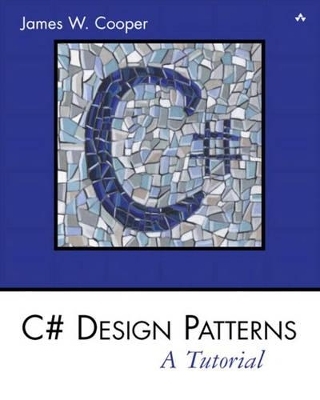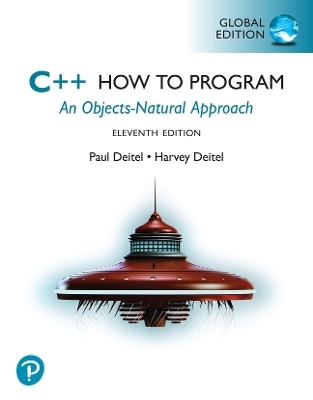
C# Design Patterns
Addison Wesley
978-0-201-84453-5 (ISBN)
- Titel ist leider vergriffen;
keine Neuauflage - Artikel merken
This is a practical book that explains how to write C# programs using some of the most common design patterns. With the release of C# and Visual Studio .NET, there is a new interest in the Microsoft development community in some of the OO world's key tools, such as UML and Design Patterns, which they had neglected before. The book covers every pattern identified in Gamma et al's Design Patterns which can be executed in C#. For each pattern, it starts with a brief verbal description, and then builds simple example programs. Each of these examples is a visual program that can be run and examined to make the pattern as concrete a concept as possible. All of the examples will be on the companion CD. The emphasis is on the practical ways to use these patterns to ease the developer's day to day work. This book should be well timed for the growing number of developers who have learned the basics of C#, and now want information on how to get the most out of C# in their real-world application development.
James W. Cooper is a research staff member in the Advanced Information Retrieval and Analysis Department at the IBM Thomas J. Watson Research Center. He is also a columnist for Java Pro magazine and a reviewer for Visual Basic Programmer's Journal. He has published 14 books, which include Principles of Object-Oriented Programming Using Java 1.1 (Ventana) and The Visual Basic Programmer's Guide to Java (Ventana). 0201844532AB05132002
Preface.
Acknowledgments.
I. OBJECT-ORIENTED PROGRAMMING IN C#.
1. What Are Design Patterns?
Defining Design Patterns.
The Learning Process.
Studying Design Patterns.
Notes on Object-Oriented Approaches.
C# Design Patterns.
How This Book Is Organized.
2. Syntax of the C# Language.
Data Types.
Converting between Numbers and Strings.
Declaring Multiple Variables.
Numeric Constants.
Character Constants.
Variables.
Declaring Variables as You Use Them.
Multiple Equals Signs for Initialization.
A Simple C# Program.
Arithmetic Operators.
Increment and Decrement Operators.
Combining Arithmetic and Assignment Statements.
Making Decisions in C#.
Comparison Operators.
Combining Conditions.
The Most Common Mistake.
The Switch Statement.
C# Comments.
The Ornery Ternary Operator.
Looping Statements in C#.
The While Loop.
The Do-While Statement.
The For Loop.
Declaring Variables as Needed in For Loops.
Commas in For Loop Statements.
How C# Differs from C.
How C# Differs from Java.
Summary.
3. Writing Windows C# Programs.
Objects in C#.
Managed Languages and Garbage Collection.
Classes and Namespaces in C#.
Building a C# Application.
The Simplest Window Program in C#.
Windows Controls.
Labels.
TextBox.
CheckBox.
Buttons.
Radio Buttons.
ListBoxes and ComboBoxes.
The Items Collection.
Menus.
ToolTips.
The Windows Controls Program.
Summary.
Programs on the CD-ROM.
4. Using Classes and Objects in C#.
What Do We Use Classes For?
A Simple Temperature Conversion Program.
Building a Temperature Class.
Converting to Kelvin.
Putting the Decisions into the Temperature Class.
Using Classes for Format and Value Conversion.
Handling Unreasonable Values.
A String Tokenizer Class.
Classes as Objects.
Class Containment.
Initialization.
Classes and Properties.
Programming Style in C#.
Delegates.
Indexers.
Operator Overloading.
Summary.
Programs on the CD-ROM.
5. Inheritance.
Constructors.
Drawing and Graphics in C#.
Using Inheritance.
Namespaces.
Creating a Square from a Rectangle.
Public, Private, and Protected.
Overloading.
Virtual and Override Keywords.
Overriding Methods in Derived Classes.
Replacing Methods Using New.
Overriding Windows Controls.
Interfaces.
Abstract Classes.
Comparing Interfaces and Abstract Classes.
Summary.
Programs on the CD-ROM.
6. UML Diagrams.
Inheritance.
Interfaces.
Composition.
Annotation.
WithClass UML Diagrams.
C# Project Files.
7. Arrays, Files, and Exceptions in C#.
Arrays.
Collection Objects.
ArrayLists.
Hashtables.
SortedLists.
Exceptions.
Multiple Exceptions.
Throwing Exceptions.
File Handling.
The File Object.
Reading a Text File.
Writing a Text File.
Exceptions in File Handling.
Testing for End of File.
A csFile Class.
Program on the CD-ROM.
II. CREATIONAL PATTERNS.
8. The Simple Factory Pattern.
How a Simple Factory Works.
Sample Code.
The Two Derived Classes.
Building the Simple Factory.
Using the Factory.
Factory Patterns in Math Computation.
Summary.
Thought Questions.
Programs on the CD-ROM.
9. The Factory Method.
The Swimmer Class.
The Events Classes.
StraightSeeding.
CircleSeeding.
Our Seeding Program.
Other Factories.
When to Use a Factory Method.
Thought Question.
Program on the CD-ROM.
10. The Abstract Factory Pattern.
A GardenMaker Factory.
The PictureBox.
Handling the RadioButton and Button Events.
Adding More Classes.
Consequences of Abstract Factory.
Thought Question.
Program on the CD-ROM.
11. The Singleton Pattern.
Creating Singleton Using a Static Method.
Exceptions and Instances.
Throwing the Exception.
Creating an Instance of the Class.
Providing a Global Point of Access to a Singleton.
Other Consequences of the Singleton Pattern.
Programs on the CD-ROM.
12. The Builder Pattern.
An Investment Tracker.
The Stock Factory.
The CheckChoice Class.
The ListboxChoice Class.
Using the Items Collection in the ListBox Control.
Plotting the Data.
The Final Choice.
Consequences of the Builder Pattern.
Thought Questions.
Program on the CD-ROM.
13. The Prototype Pattern.
Cloning in C#.
Using the Prototype.
Cloning the Class.
Using the Prototype Pattern.
Dissimilar Classes with the Same Interface.
Prototype Managers.
Consequences of the Prototype Pattern.
Thought Question.
Programs on the CD-ROM.
Summary of Creational Patterns.
III. STRUCTURAL PATTERNS.
14. The Adapter Pattern.
Moving Data between Lists.
Making an Adapter.
Using the DataGrid.
Detecting Row Selection.
Using a TreeView.
The Class Adapter.
Two-Way Adapters.
Object versus Class Adapters in C#.
Pluggable Adapters.
Thought Question.
Programs on the CD-ROM.
15. The Bridge Pattern.
The Bridger Interface.
The VisList Classes.
The Class Diagram.
Extending the Bridge.
Windows Forms as Bridges.
Consequences of the Bridge Pattern.
Thought Question.
Programs on the CD-ROM.
16 The Composite Pattern.
An Implementation of a Composite.
Computing Salaries.
The Employee Classes.
The Boss Class.
Building the Employee Tree.
Self-Promotion.
Doubly Linked Lists.
Consequences of the Composite Pattern.
A Simple Composite.
Composites in .NET.
Other Implementation Issues.
Thought Questions.
Programs on the CD-ROM.
17. The Decorator Pattern.
Decorating a CoolButton.
Handling Events in a Decorator.
Layout Considerations.
Control Size and Position.
Multiple Decorators.
Nonvisual Decorators.
Decorators, Adapters, and Composites.
Consequences of the Decorator Pattern.
Thought Questions.
Programs on the CD-ROM.
18. The Facade Pattern.
What Is a Database?
Getting Data Out of Databases.
Kinds of Databases.
ODBC.
Database Structure.
Using ADO.NET.
Connecting to a Database.
Reading Data from a Database Table.
Executing a Query.
Deleting the Contents of a Table.
Adding Rows to Database Tables Using ADO.NET.
Building the Facade Classes.
Building the Price Query.
Making the ADO.NET Facade.
The DBTable Class.
Creating Classes for Each Table.
Building the Price Table.
Loading the Database Tables.
The Final Application.
What Constitutes the Facade?
Consequences of the Facade.
Thought Question.
Program on the CD-ROM.
19. The Flyweight Pattern.
Discussion.
Example Code.
The Class Diagram.
Selecting a Folder.
Handling the Mouse and Paint Events.
Flyweight Uses in C#.
Sharable Objects.
Copy-on-Write Objects.
Thought Question.
Program on the CD-ROM.
20. The Proxy Pattern.
Sample Code.
Proxies in C#.
Copy-on-Write.
Comparison with Related Patterns.
Thought Question.
Program on the CD-ROM.
Summary of Structural Patterns.
IV. BEHAVIORAL PATTERNS.
21. Chain of Responsibility.
Applicability.
Sample Code.
ListBoxes.
Programming a Help System.
Receiving the Help Command.
A Chain or a Tree?
Kinds of Requests.
Examples in C#.
The Chain of Responsibility.
Thought Question.
Programs on the CD-ROM.
22. The Command Pattern.
Motivation.
Command Objects.
Building Command Objects.
Consequences of the Command Pattern.
The CommandHolder Interface.
Providing Undo.
Thought Questions.
Programs on the CD-ROM.
23. The Interpreter Pattern.
Motivation.
Applicability.
A Simple Report Example.
Interpreting the Language.
Objects Used in Parsing.
Reducing the Parsed Stack.
Implementing the Interpreter Pattern.
The Syntax Tree.
Consequences of the Interpreter Pattern.
Thought Question.
Program on the CD-ROM.
24. The Iterator Pattern.
Motivation.
Sample Iterator Code.
Fetching an Iterator.
Filtered Iterators.
The Filtered Iterator.
Keeping Track of the Clubs.
Consequences of the Iterator Pattern.
Programs on the CD-ROM.
25. The Mediator Pattern.
An Example System.
Interactions between Controls.
Sample Code.
Initialization of the System.
Mediators and Command Objects.
Consequences of the Mediator Pattern.
Single Interface Mediators.
Implementation Issues.
Program on the CD-ROM.
26. The Memento Pattern.
Motivation.
Implementation.
Sample Code.
A Cautionary Note.
Command Objects in the User Interface.
Handling Mouse and Paint Events.
Consequences of the Memento.
Thought Question.
Program on the CD-ROM.
27. The Observer Pattern.
Watching Colors Change.
The Message to the Media.
Consequences of the Observer Pattern.
Program on the CD-ROM.
28. The State Pattern.
Sample Code.
Switching between States.
How the Mediator Interacts with the StateManager.
The ComdToolBarButton.
Handling the Fill State.
Handling the Undo List.
The VisRectangle and VisCircle Classes.
Mediators and the God Class.
Consequences of the State Pattern.
State Transitions.
Thought Questions.
Program on the CD-ROM.
29 The Strategy Pattern.
Motivation.
Sample Code.
The Context.
The Program Commands.
The Line and Bar Graph Strategies.
Drawing Plots in C#.
Making Bar Plots.
Making Line Plots.
Consequences of the Strategy Pattern.
Program on the CD-ROM.
30. The Template Method Pattern.
Motivation.
Kinds of Methods in a Template Class.
Sample Code.
Drawing a Standard Triangle.
Drawing an Isosceles Triangle.
The Triangle Drawing Program.
Templates and Callbacks.
Summary and Consequences.
Programs on the CD-ROM.
31. The Visitor Pattern.
Motivation.
When to Use the Visitor Pattern.
Sample Code.
Visiting the Classes.
Visiting Several Classes.
Bosses Are Employees, Too.
Catch-All Operations with Visitors.
Double Dispatching.
Why Are We Doing This?
Traversing a Series of Classes.
Consequences of the Visitor Pattern.
Thought Question.
Program on the CD-ROM.
Bibliography.
Index. 0201844532T08292002
| Erscheint lt. Verlag | 27.9.2002 |
|---|---|
| Verlagsort | Boston |
| Sprache | englisch |
| Maße | 187 x 234 mm |
| Gewicht | 660 g |
| Themenwelt | Mathematik / Informatik ► Informatik ► Programmiersprachen / -werkzeuge |
| ISBN-10 | 0-201-84453-2 / 0201844532 |
| ISBN-13 | 978-0-201-84453-5 / 9780201844535 |
| Zustand | Neuware |
| Haben Sie eine Frage zum Produkt? |
aus dem Bereich
